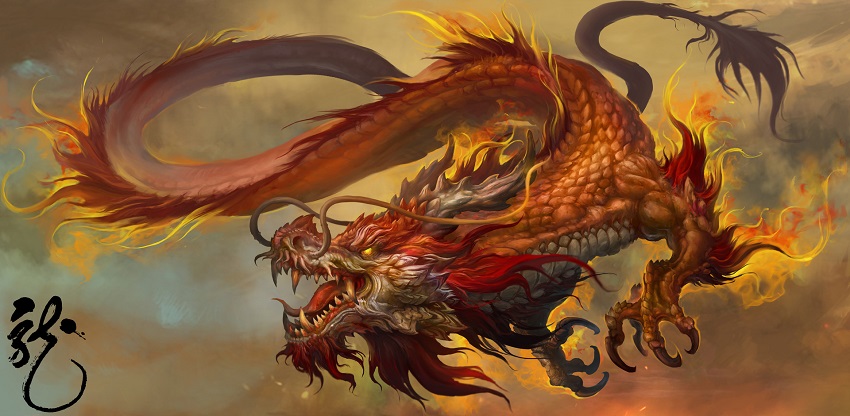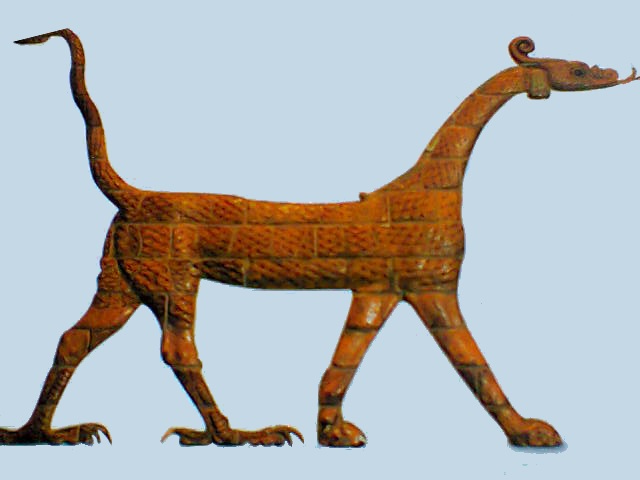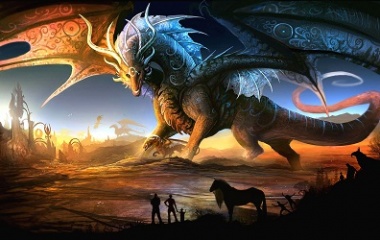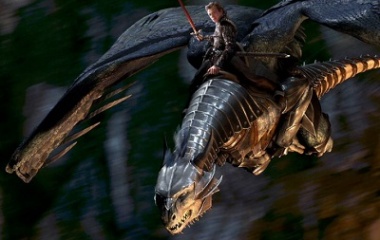What is a Dragon?
As one of the most popular mythological creatures in modern day, the dragon is no mystery. It does, however, have a lengthy history that many people are unaware of. When most people envision a dragon, they think of a large reptile-like creature with enormous wings that breathes fire and attacks castles. However, like all creatures of ancient lore, the dragon had more humble beginnings.

Dragon mythology has existed almost as long as people have. In fact, many of the early Mesopotamian cultures and other ancients in the Near East have rich oral histories that tell of mighty storm gods saving the people from evil giant serpents. These serpents often had many terrifying features, ranging from fluorescent skin to the ability to breathe fire and fly. These myths were the foundation of the modern perspective on dragons.
So how can one accurately describe the fearsome dragon? For starters, it seems that a dragon is actually any form of serpent that has an especially fearsome nature. This is indicated by the word ‘drakon’ that the English word ‘dragon’ was derived from. ‘Drakon’ means ‘large serpent’ or ‘sea serpent.’ Additionally, most dragons are described as being evil in nature. This is not always the case, however, as evidenced by Chinese mythology. There are times that dragons are also shown as benevolent and knowledgeable creatures.
The Evolution of the Dragon
In early cultures, the dragons were often seen as mighty serpents and beasts that were either extremely benevolent or fearsome and difficult to kill. The beliefs of a region are often influenced by geographical location. Eastern cultures often saw dragons as a knowledgeable deity that had power over storms and water. Additionally, they also saw the dragon as a powerful and benevolent creature that could ward off evil.
Western cultures had a very different perspective. They often saw dragons as evil beasts that reveled in killing and chaos. Many dragons are depicted as living in dark and dangerous places that were often perilous for men in ancient times. Additionally, they were often thought to guard hoards of treasure.
In both cultures, dragons were largely thought to be wingless before the Medieval Ages. During this time, the Western cultures began to transform their dragon portrayals, while the Eastern cultures continued with their traditions.
Myths Associated with Dragons
While many people know that dragons are thought to guard hoards of treasure, there are also other myths that still surround the creature. One such myth is that dragon’s blood held special properties that gave anyone with access to it unique opportunities. If, for example, a person was to dip a sword or knife into dragon blood and stab someone with it, their wound would never heal. However, not all things associated with dragon blood are bad. It is also thought that dragon blood gives a person the ability to see into the future.
It is also thought that dragons from the Eastern world have the ability to change size and shape. In fact, most of the dragons from Eastern legends have the ability to change into human form at will.
Early Dragons in Ancient Cultures
In early cultures, there are many tales of benevolent storm gods that defeated giant sea serpents in order to save mankind. There are many versions of this tale – one of the most popular in modern day being Yahweh’s predicted battle with the mighty Leviathan. These tales give insight to the foundations of many cultures that exist in modern day.
Mushussu
The mushussu (more popularly known as the sirrush due to a mistranslation), was an ancient dragon of the Mesopotamian region that was thought to be an attendant to the gods. This creature was thought to actually live in the Babylonian palaces – until supposedly meeting its end at the hands of the biblical prophet Daniel.

The story goes that the Babylonian priests took Daniel to the temple of Bel (Nebuchadnezzar’s god) and showed him a great dragon that many believe to be the mushussu. Upon seeing the creature, they challenged him to match his invisible god (Yahweh) against their living god. Eventually, Daniel poisoned the mushussu.
Apep
Apep was considered to be a giant serpent that was the greatest enemy of the sun god, Ra. There are many depictions of him in Egyptian mythology and ancient Egyptian Religion because of his great influence. While known to be an evil deity that embodied chaos and destruction, he was also one of the most important symbols in their culture. Tales of Apep describe him as a being of impressive size – some sources claim that he stretched to nearly 16 yards in length (48 feet).
Tales from ancient sources tell us that Apep was associated with the underworld. It was thought that the sun set at night and rose in the morning to signify the times during which Ra (the sun god) must descend into the underworld and battle with Apep to protect the people above. There are also tales that suggest that thunderstorms were caused by Apep’s battles with Set (god of storms, violence, etc.).
Vritra
Vritra is a giant dragon that comes from early Vedic religion. He is thought to be an evil entity and is known to be the personification of drought. Some sources also tell us that he was the first born of the dragons. He is an enemy of Indra – the benevolent deity that was seen as a protective god.
Vritra was known to block the course of the rivers that were vital to the people of these lands. He held these waters hostage until he was defeated and slain by the mighty Indra.
Leviathan
Leviathan is one of the most popular serpents in mythology of modern day due to the large influence of Christianity. Lore tells us that Leviathan is a terrible serpent that may stretch 300 miles in length. He has double armored scales that are fitted so tightly together that no air can get through. Leviathan is also known to have glowing eyes and skin, as well as the ability to breathe fire.
At one point in time, there were supposedly two Leviathans – one male and one female. However, they were corrupted shortly after their creation and eventually the female had to be killed so that their spawn would not devour the world. Legend tells us that Yahweh will descend to the earth at the end of days and defeat this great serpent once and for all.
Typhon, Hydra, and other Greek Serpent Monsters
While all cultures have mythology that is heavily influenced by serpents and dragons, Greek mythology is perhaps the most well known in modern day. Two of the most famous stories concern Typhon and Hydra.

Typhon was a serpent monster that was created by Zeus’ mother because she felt that he had been at fault for the way he had overthrown his father. Typhon rose up and terrorized the gods that lived on Mount Olympus. He was almost unstoppable – but Zeus was able to overcome the monster with the help of a few of his siblings.
Hydra was a multi-headed serpent that was said to live in the lake of Lerna. At the time, Lerna was considered to be the entrance to the underworld. Hydra was thought to be undefeatable because every time one of its heads was cut off, two grew back in its place. In addition to this, one of the heads of Hydra was immortal. The dragon was eventually overcome by Hercules, who killed it but cutting off its heads and cauterizing the wound. He then took the immortal head and buried it underground.
The Dragon is Modernized by the Middle Ages
In the Medieval times, tales of dragons from several cultures including Graeco-Roman writings, Biblical tales, and Western European legends. The result was the dragon that is most often thought of in modern day. This transformation took place during a 300 year timespan from the 11th century to the 13th century.
One of the most famous dragon tales to arise from this time was the one that would give rise to the child prophet Merlin. It is said that in the 12th century a warlord by the name of Vortigern was trying to build a tower on Mount Snowdon as protection against the Anglo-Saxons. He was unsuccessful in his efforts however, because each time the tower was constructed it was swallowed up by the ground.
The child prophet Merlin informed the warlord that his tower wouldn’t stand because there was an underground pool directly below his foundation. In it lay two sleeping dragons – one white and one red. Vortigern had the pool drained and the two dragons emerged. As soon as they were exposed to the surface, they began fighting. Merlin prophesized that the white dragon would prevail over the red dragon, symbolizing England’s conquest of Wales. However, he also tells that the red dragon would eventually return and defeat the white dragon. The white dragon won, as prophesized.
Legends of Dragons in Many Cultures
Throughout history, many cultures both embraced and abhorred dragons and the dangers that accompanied them. There are hundreds of stories of heroes who rose up to conqueror dragons, as well as tales of dragons that helped humanity in their time of need.
Thakane – Dragon-Slaying Princess
The tale of Thakane comes from South African mythology. It tells of a young princess named Thakane. She was the daughter of a great and powerful chief. Unfortunately, her father and mother passed away before she and her brothers were fully grown. This left her with the responsibility of raising them to be great warriors as well. This led to her taking care of all their needs and thinking around their lazy and prideful tendencies.
When they were of age, Thakane took her two brothers to a warrior training school up in the mountains. After months of training they were ready to graduate – but there was soon an issue. It was the custom of Thakane’s people to give a graduating warrior a garments and a shield made of the skins of animals killed by their fathers. Thakane had prepared the skins of great beasts (like lions and other predators) for this purpose, but her prideful brothers didn’t think these skins were good enough. Instead, they wanted a nanabolele skin.
A nanabolele is a water-dwelling dragon that comes from Basotho mythology. They were fearsome creatures that were known to give off a fluorescent light in the dark and were always surrounded by a cloud of red smoke when they arrived. They were extremely difficult to kill – going after a nanabolele was often considered to be a suicide mission. However, Thakane was determined to uphold her family’s honor and started looking for warriors to accompany her for her journey.
Thakane eventually found the lair of the nanabolele’s and slayed the biggest beast she could find when they fell asleep. The old woman gave her a magical pebble that would protect her and the other hunters from the surviving nanaboleles and Thakane returned home a hero. She had the proper graduation gifts made for her younger brothers and upheld her family honor.
Saint George & The Dragon
One of the most popular accounts in Europe of dragon mythology is the tale of Saint George and the dragon. This story begins with the plight of the city of Silene, Libya. The city of Silene was plagued by a dragon that was feeding off of their sheep herds. They fought against the beast until it killed a young shepherd. At this point, the city decided that it would be easier to leave two sheep by the lake each morning so that the dragon’s hunger would be satisfied. Eventually, however, the dragon ate all of the sheep and the villagers were forced to sacrifice their own children to the creature. This was done through a random lottery.

One day, the King’s daughter was chosen. Distraught, he pleaded for the mercy and asked that a different sacrifice be made. His cries were ignored, however, and the young girl was chained to the rock by the lake for the dragon. Luckily for the King, Saint George happened to wander into their province and saw the young girl by the lake in the early hours of the morning. He waited for the dragon to appear, and when it tried to eat the young girl he stabbed it with its lance. He then tamed it by making the sign of the cross and using the princess’ girdle as a lead for the beast. St. George and the princess led the now docile creature into town and promised to kill the dragon if the people converted to Christianity. They agreed and he slayed the beast.
La Gargouille – The First Gargoyle
In early France, a dragon by the name of La Gargouille was terrorizing the people who lived by the river Seine. It was creating terrible floods that ruined crops and killed people. It also sank ships, resulting in the loss of wealth and life. Desperate, the people of Rouen decided to make a human sacrifice to the dragon once a year to appease its hunger and save their city. This was done for several years before a priest named Romanus happened upon their town.
Romanus was traveling when he stopped in the city of Rouen and heard the plight of the people. He told them that if they built a church in their city he would slay the dragon. They agreed and built him a church. When it had been finished, he went out to face the terrible La Gargouille. After a struggle, he slayed the dragon. He then severed the head of the beast and mounted it to the walls of the city. This is how the first gargoyle was created.
The Midgard Serpent
It is thought that the Midgard Serpent was one of the children of the giant, Loki, in Norse mythology. This evil water serpent is known to fight with Thor – in the end days it is fated that they will battle to the death.
The Midgard Serpent is known to be so large that it can wrap itself around the full length of the world and grasp its tail between its teeth (hence its name). It is thought that the end of the world will come when the beast decides to let go of its tail.
The Vikings took much inspiration from the tale of the Midgard Serpent. Because of the creature, the Vikings were inspired to carve dragonheads onto the front of their longships. These ships were called ‘drakkar’ (dragon ships) and were used to strike fear into the hearts of their enemies when they were seen approaching in the distance.
Chinese Legends
Although many cultures have a deep-rooted fear for the dragon and other serpent-like creatures, Chinese mythology has a very different perspective. They believe that the dragon is responsible for many benevolent gifts such as good rains that in turn bring good harvests – and perhaps even life itself. There are several tales that suggest that the dragon is the most important mythological creature of all. In fact, this creature is so respected in the Chinese culture that for many years only emperors were allowed to have any item that represented or was associated with the dragon.
The Dragon Kings of China

The Dragon Kings were thought to be great and powerful deities that lived in magical crystal palaces underneath the sea. Many people thought these castles were part of the Underworld, and as such could only be reached through secret entrances and caves.
There were thought to be five Dragon Kings. They controlled the rains and ruled over the waters. Four of the five kings were positioned at the cardinal points (North, South, East, West) and ruled over their own section of sea. The chief Dragon King lived in the middle of these four kings.
It was thought that the Dragon Kings were deified forces of nature. When the Water Dragons rose to the surface of the ocean, it was thought that they caused typhoons. When they flew, there was heavy rain and sometimes hurricanes.
Dongfu – the Great Dragon Trainer
Legend tells us that there once lived a man who had a great love for dragons even though he was not part of the royal family. He was born with the unique gift to understand the will of the dragons – which in turn allowed him to raise these beasts to be good and noble creatures.
When Emperor Shin became aware of his abilities, he invited the man to live in the royal palace so that he may train dragons. He even gave Dongfu a new name that was normally reserved for the royal family – ‘Huanlong.’ This new name (Huanlong) meant ‘dragon raiser.’ Thus, Huanlong went on to live a long and prosperous life.
Miao Creation Legend
An ancient Miao legend tells us that dragons may be responsible for the existence of humankind. According to their traditions, the first people had their origins as monkeys.
There was a Great Dragon that lived in a cave. There were also monkeys that came inside his cave to play. One day, the Great Dragon breathed onto these monkeys and thus, the first men and women were created.
Origin of the Dragon Myth
There are several theories as to where the dragon myth could have come from. These theories span from inspiration from existing creatures to undiscovered lifeforms and fossil remains. Some also believe that these giant serpents were created as a way of demonstrating the power of certain religious deities.
Existing Creatures Inspired Dragon Myths
One of the most obvious answers to what inspired the dragon myth is simply that existing creatures inspired the stories. This theory is a likely candidate – especially when looking at stories like ‘Thakane, the Princess Dragon Slayer.’ It is apparent to most who study this story that the water dragon in question is actually a crocodile. Other creatures who are thought to have inspired various stories include snakes, eels, and monitor lizards.
There are also those who believe that the inspiration may have come from an undiscovered species of reptile. While many are doubtful that a species of such a large size could have survived to modern day without being noticed, it is still an accepted theory.
Fossil Remains Inspired Dragon Myths
There are also those who believe our ancestors may have been inspired by the fossil remains of dinosaurs and other megafauna when they created their tales. This is another popular theory, especially since many of the cultures with dragon tales are in areas where many fossils have been discovered.
Religion Inspired Dragon Myths
Another theory is that religion could have inspired the dragon myths. This is partially because it was so common for Mesopotamian and Near Eastern cultures to have stories of storm gods overcoming mighty serpent beasts. One of the most popular of these myths to survive in modern day is the tale of Yahweh and his prophesized battle with Leviathan.
Fear Inspired Dragon Myths
Last, but certainly not least, it is also possible that our own fear and primal instincts inspired the legends. Many scientists hypothesize that humans may have a pre-programed fear instinct towards snakes and other reptiles. This theory, combined with the places that dragons were said to exist (oceans, lakes, dark caves, and other perilous locations) could suggest that dragon myths were created as a cautionary tale to man.











Does the Chinese dragon have any special or magical attributes?
China Dragon is different from Western one,their appearance and power too…
Calling all these creatures is deceptive, if you remove the expectation that this myth is a dragon (try eliminate the word dragon when you read about it, know only by the details) then the creature being described takes a whole new twist. Dragon? That’s an anglicisation anyway.
Taken from etymonline.com:
dragon (n.)
early 13c., from Old French dragon, from Latin draconem (nominative draco) “huge serpent, dragon,” from Greek drakon (genitive drakontos) “serpent, giant seafish,” apparently from drak-, strong aorist stem of derkesthai “to see clearly,” from PIE *derk- “to see.” Perhaps the literal sense is “the one with the (deadly) glance.”
The young are dragonets (14c.). Obsolete drake “dragon” is an older borrowing of the same word. Used in the Bible to translate Hebrew tannin “a great sea-monster,” and tan, a desert mammal now believed to be the jackal.
Related Entries
draco, draconian, dragonfly, dragoon, drake, pendragon, rankle, snapdragon, tarragon